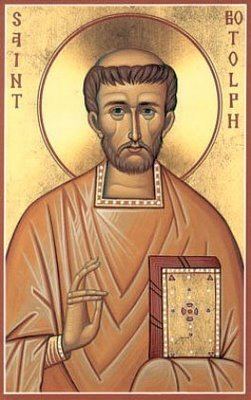Name Botwulf Thorney | Died 680 AD | |
 | ||
Venerated in Anglican Communion
Orthodox Church
Roman Catholic Church Feast 17 June (England)
25 June (Scotland). Translation of his relics: 1 December Patronage the patron saint of travellers and farming | ||
Botwulf of Thorney (also called Botolph, Botulph or Botulf; died around 680) was an English abbot and saint. He is the patron saint of travellers and the various aspects of farming. His feast day is celebrated either on 17 June (England) or 25 June (Scotland), and his translation falls on 1 December.
Contents
Life and works
Little is known about Botwulf's life, other than doubtful details in an account written four hundred years after his death by the 11th-century monk Folcard. The Anglo-Saxon Chronicle records for the year 6531: "The Middle Angles, under earldorman Peada, received the true faith. King Anna was killed and Botulf began to build the church at Ikanho". Botolph founded the monastery of Ikanhoe in Suffolk. Icanho, which means 'ox hill', has been identified as Iken, located by the estuary of the River Alde in Suffolk; a church still remains on top of an isolated hill in the parish.2 The Life of St Ceolfrith, written around the time of Bede by an unknown author, mentions an abbot named Botolphus in East Anglia, "a man of remarkable life and learning, full of the grace of the Holy Spirit".3 In common with many early English Christians, he is believed to have studied at Rath Melsigi in Ireland.
Botwulf is supposed to have been buried originally at his foundation of Icanho, but in 970 Edgar I of England gave permission for Botwulf's remains to be transferred to Burgh, near Woodbridge, where they remained for some fifty years before being transferred to their own tomb at Bury St Edmunds Abbey on the instructions of Cnut. The saint's relics were later transferred again, along with those of his brother Adulf, to Thorney Abbey, although his head was transferred to Ely Cathedral and various body parts to other houses, including Westminster Abbey.
Church dedications
Many English churches are dedicated to Botwulf. According to the Oxford Dictionary of Saints, 64 ancient English churches were dedicated to him, but later research has suggested the true number may have been as high as 71, with a high concentration of dedications in East Anglia. St Botolph's Church in Boston, Lincolnshire, known locally as "The Stump", is one of the most famous. Boston, or 'Botwulf's town' also gave Boston, Massachusetts its name. St Botolph's Priory in Colchester, Essex, the first Augustinian monastery in England, was built on an earlier Saxon church dedicated to Botolph. St Botolph's Church in Hardham, West Sussex, houses some of the most ancient surviving wall paintings in Britain, including the earliest known depiction of St George in England.
In his role as a patron saint of travellers, four City of London churches were dedicated to him, all of which were close to gates in the City walls: St Botolph Billingsgate, which was destroyed in the Great Fire and never rebuilt; St Botolph's, Aldersgate, St Botolph-without-Bishopsgate, where the poet John Keats was baptised, and St Botolph's Aldgate. It is believed that these dedications were made because the churches provided places for incoming travellers to give thanks for their safe arrival and for outgoing travellers to pray for a safe journey. An alternative possibility is that the churches were dedicated to the saint because his relics came through the four gates when Edgar moved them from Iken to Westminster Abbey.
Beyond the North Sea, Budolfi Church (Sankt Budolfi kirke) in Aalborg, Denmark, originally a smallish building, grew to be the major church of the town by the late Middle Ages and is now the cathedral church of the diocese of Aalborg.
Secular connections
He is remembered in the names of both the market town of Boston, Lincolnshire in the United Kingdom and Boston, Massachusetts in the United States. Boston was originally Botolphston (from "Botolph's stone" or "Botolph's town").
In Boston, Massachusetts, St Botolph gives his name to the St Botolph Club, a private club, a street in Boston's Back Bay neighborhood, and the President's House at Boston College. There is also a St Botolph Street in London, and several London churches are dedicated to him.
Botulph's Bridge or Bottlebridge was a hamlet just southeast of Peterborough, now part of the city.
University of Cambridge's poetry journal in the 1950s, to which Ted Hughes contributed, was called St Botolph's Review. It was named for St Botolph's Church, Cambridge as one of its founders, Lucas Myers, lived at the rectory of St Botolph's Church in Cambridge. A second edition of the journal was published in 2006. "St Botolph's College" is now frequently used as a hypothetical college in Cambridge University communications and Tripos examinations alongside the "Department of Important Studies".
The parish of Buttsbury in Essex was initially called Botolfvespirie, meaning Botolph's or Botwulf's Pear Tree. It is sometimes surmised that the name refers to a tree under which St Botolph preached.
